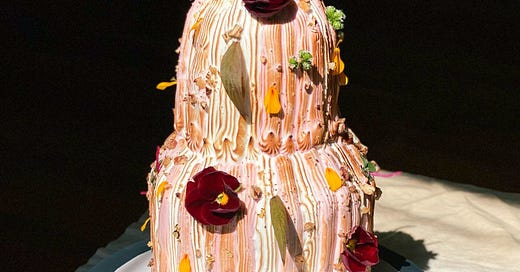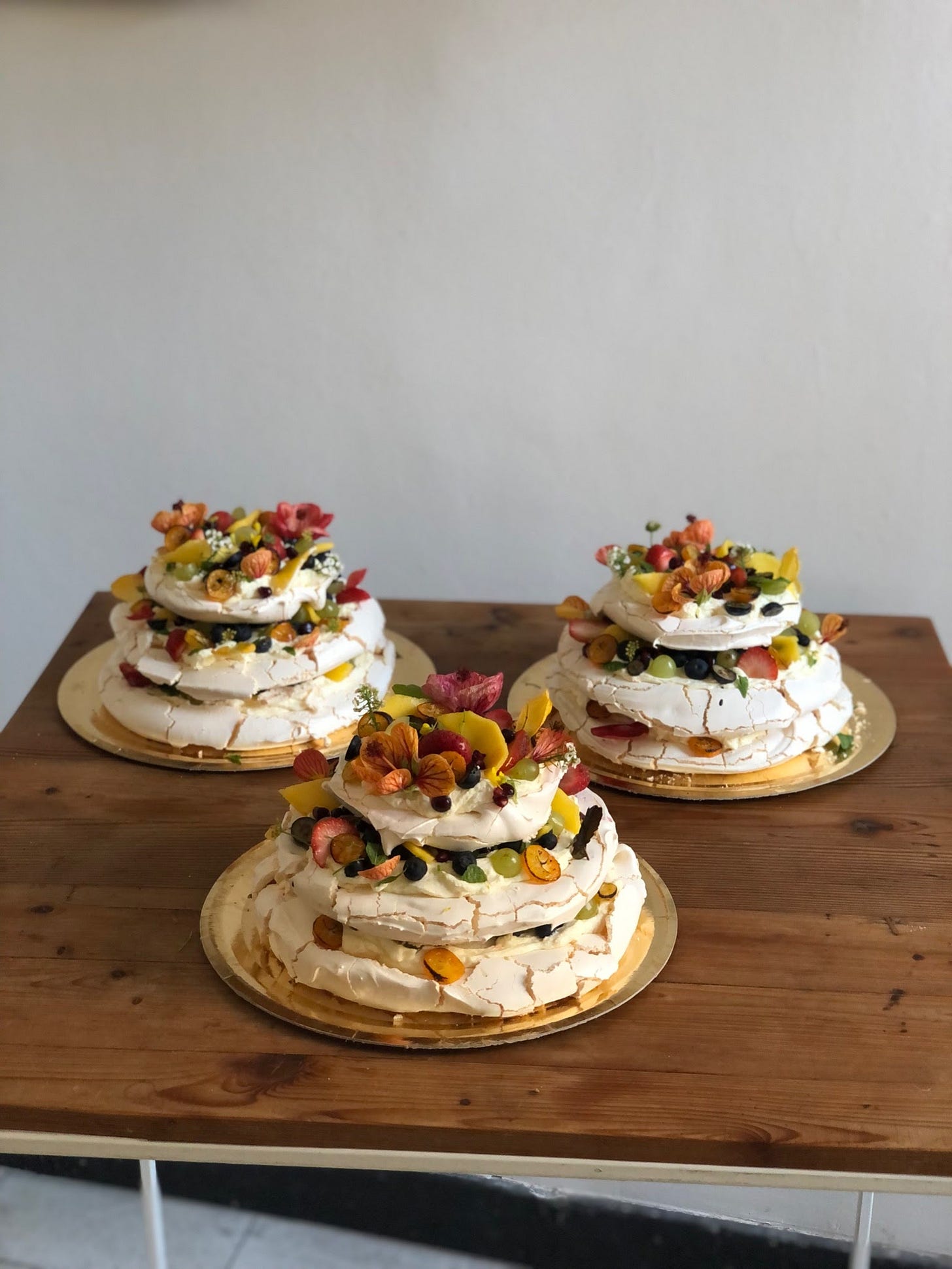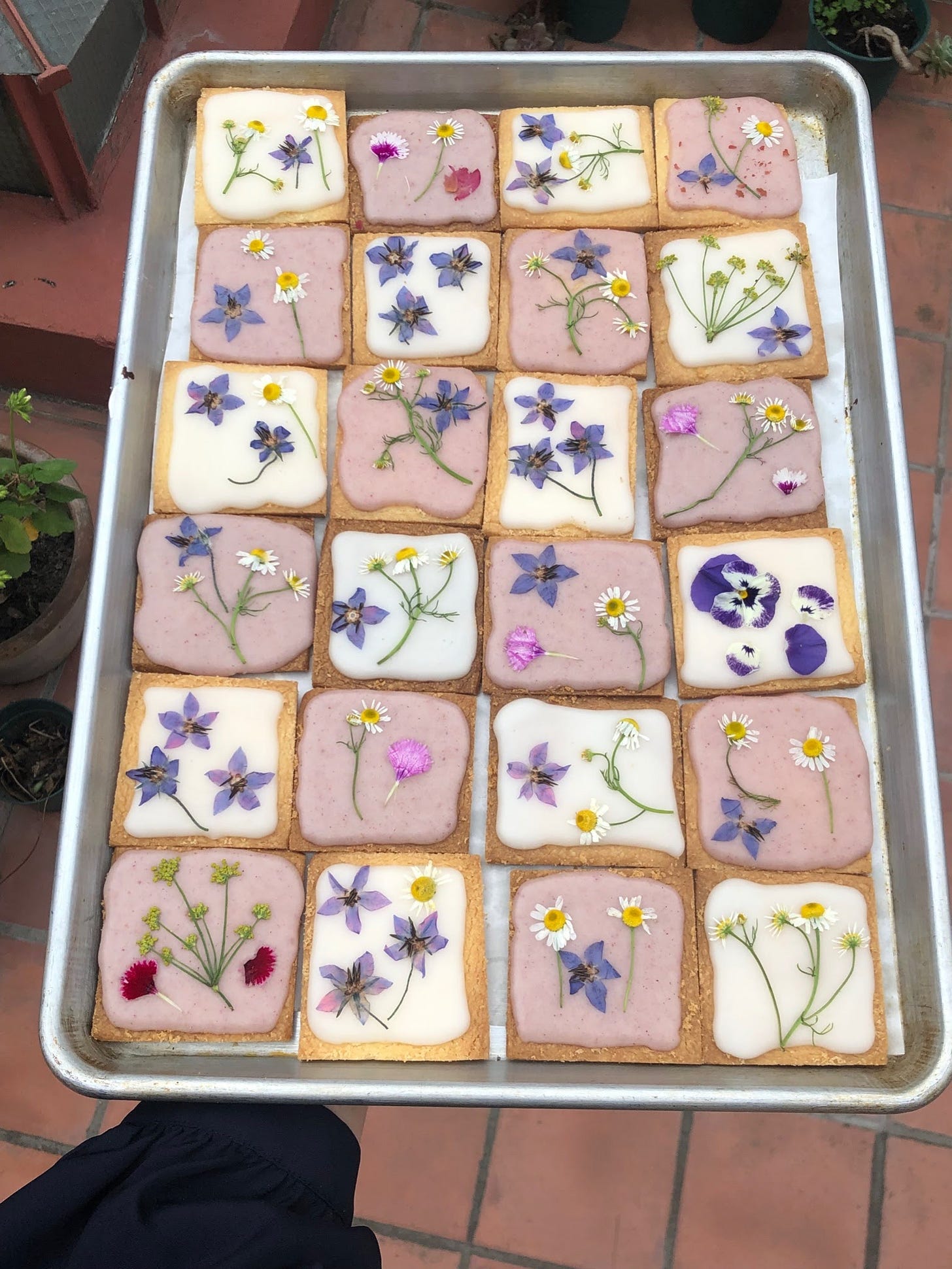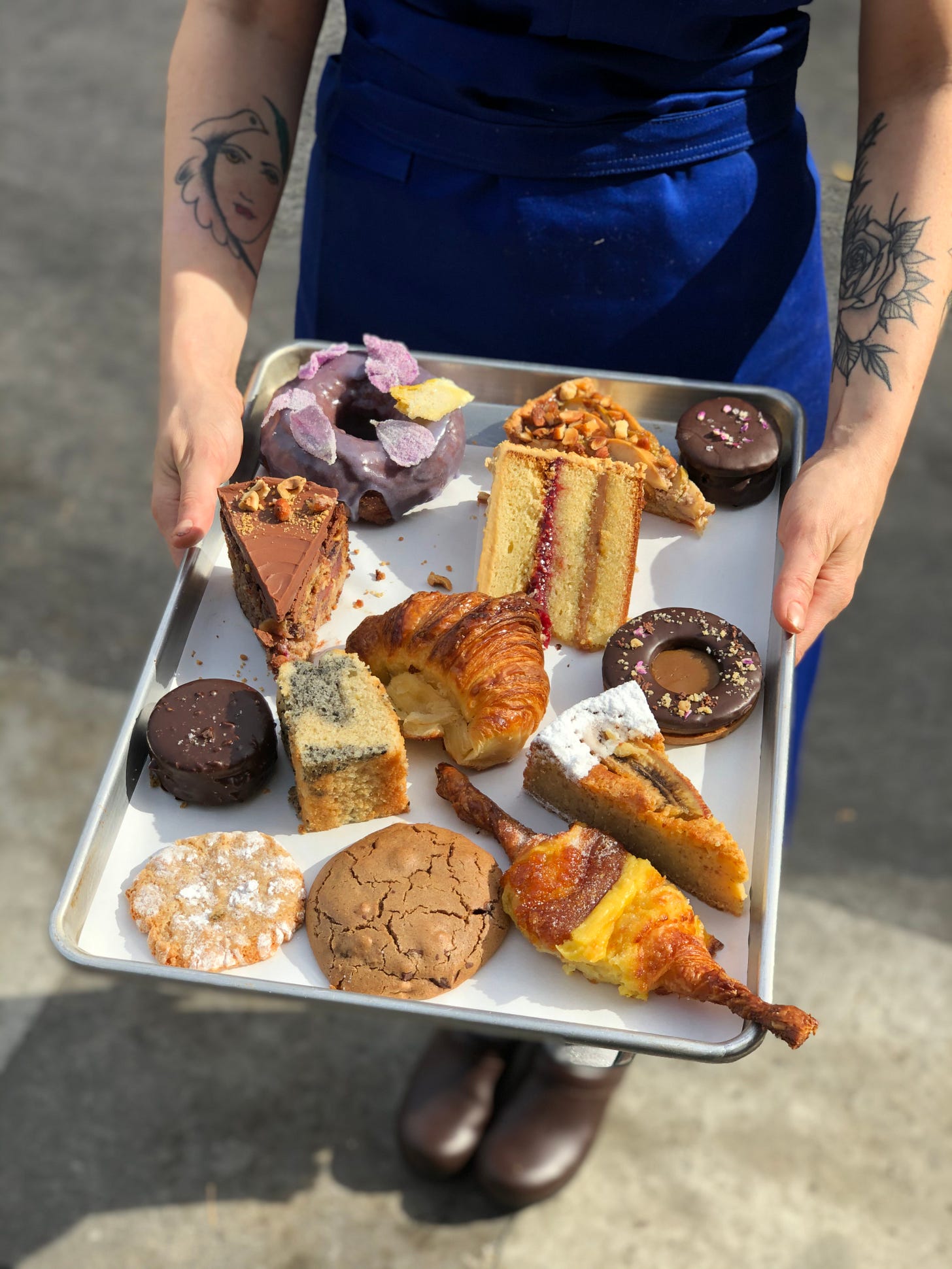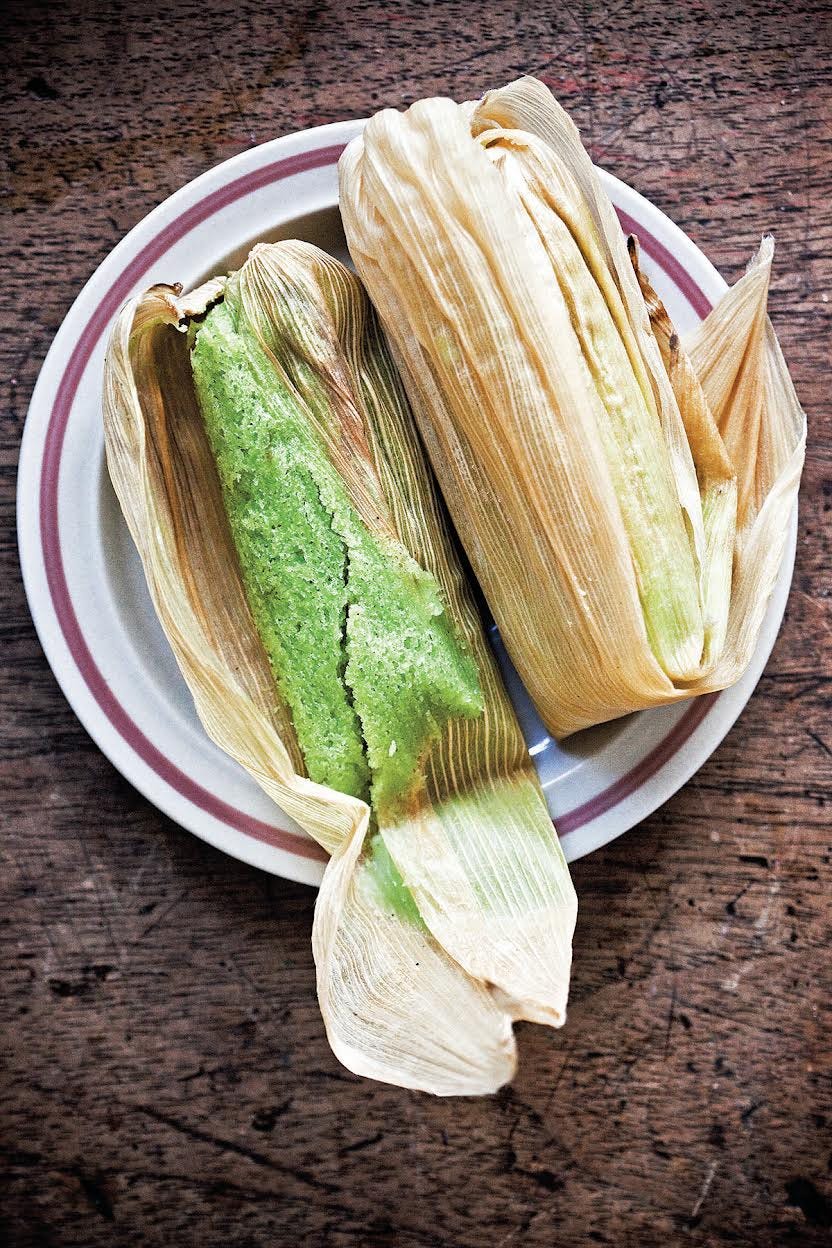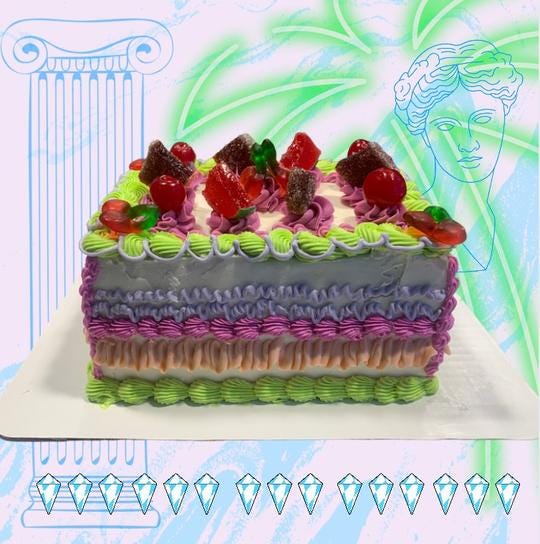#11: Just Desserts
From sculptural cakes to vegan bakes, pastry pros with practices that are anything but cookie-cutter
Greetings lovely readers.🧁 Preheat your ovens and grab your scales, we’re getting into the delicious world of baked goods. From sourdough starters to Instagram-famous banana breads to a wave of new pastry pop-ups in practically every city, baking has stolen the hearts and stomachs of folks across the globe. More than the unofficial official quarantine hobby, for many, it’s provided crucial comforts during these uncertain times, both personally and professionally. Some find joy in ancestral elements, revisiting family recipes in an effort to return to roots, while others are inspired to experiment, pushing people to reimagine what “dessert” can taste like. Often testing and retesting, these people embody precision, but many would challenge the often-repeated remark that baking is “simply a matter of science.”
We’ll kick things off with some surreal, sculptural desserts from Hyun Jung Jun, the multimedia artist behind the dreamy account Dream Cake Test Kitchen. Cake connoisseurs Rae Robey and Chula Galvez talk shop – exploring the beauty in imperfect bakes, their favorite Dickinson-inspired floral designs, and the trials and tribulations of developing plant-based practices. Fany Gerson (of La New Yorkina and Fan Fan fame) gives us the scoop on her father’s famous tamal recipe just in time for Día de los Muertos. And, as per usual, we’re sharing a full roundup of things our friends and collaborators are sweet on these days.
*Sometimes email providers will clip the end of our messages due to size; be sure to click through for the full issue!*
Have Your Cake
Hyun Jung Jun, orange buttermilk cake with white chocolate buttercream, green pea filling, toasted meringue, cashew, baked for Dream Cake Test Kitchen, 7x7x10”, 2021.
Originally from South Korea and currently based in Chicago, Hyun Jung Jun is an artist whose installations are measures and meditations that take up more time than they do space. Working with commonplace commodities such as candles, bread, wooden structures, sewn and painted wearables, Jun’s work borrows from familiar, domestic language to describe and search the ornate identities of our individuality and culture. Jun received her BFA at School of the Art Institute of Chicago and an MFA in Art Theory and Practice at Northwestern University. Her recent exhibitions include Goldfinch, LVL3, the Gaylord & Dorothy Donnelley Foundation with Chicago Artists Coalition, No Place Gallery, Hans Gallery, The Drawing Room at Arts Club of Chicago, Good Naked, EXPO CHICAGO and Everybody. Her work has recently been featured in Chicago Reader, the New York Times and Newcity Magazine. Jun is one of Newcity’s breakout artists for 2021.
Recently, Jun’s work has expanded to the kitchen in a project titled Dream Cake Test Kitchen. Jun’s cakes take the form of sculptural landscapes that utilize meringue, buttercream and edible flowers as ephemeral, edible gestures. Initially, the project was a simple shared experience between friends and family, but has now grown into an unlimited edition of fantastical forms for public consumption, often existing as a collaboration between the recipient and Jun. The artist has talked about baking and decoration as a sketch or doodle that takes on the shape of real and imagined landscapes, edible extensions of her art practice that is accessible to all.
Something to Chew On
Chula Galvez & Rae Robey on Emily Dickinson, Edible Flowers, and Plant-Based Bakes
Rae Robey (she/they) is a Baltimore-based baker, food writer, and “digital content specialist” (slightly nonsense title they just made up for this particular bio). She sells cakes through Instagram and runs bake sales to raise money for a local bail fund.
Pastry Chef Chula Galvez (she/her) started baking cookies when she was in elementary school and recalls her grandpa as her first teacher. Even though she obtained her professional diploma at Gastronomic Argentine Institute, those first cooking years remain a strong inspirational source for her. In between her scholastic accomplishments, she started her own bakery venture in 2014, offering personalized catering services and creating unique sweet tables with artistic themes for gallery openings, fashion shows, and pop-ups. Chula’s desserts have a strong visual identity, playful and quirky flavors, and always use natural ingredients. She considers herself a food nerd and is always looking for new ways of expressing her discoveries; her style combines some Argentine nostalgia with a vast palate that has traveled all over the world. She designs the dessert menus for restaurants in NYC, MIA, and BA such as Dimes and Orilla Bar & Grill. She currently resides in Buenos Aires, Argentina where she is about to open her own restaurant/bakery.
*Interview has been condensed and edited for clarity.*
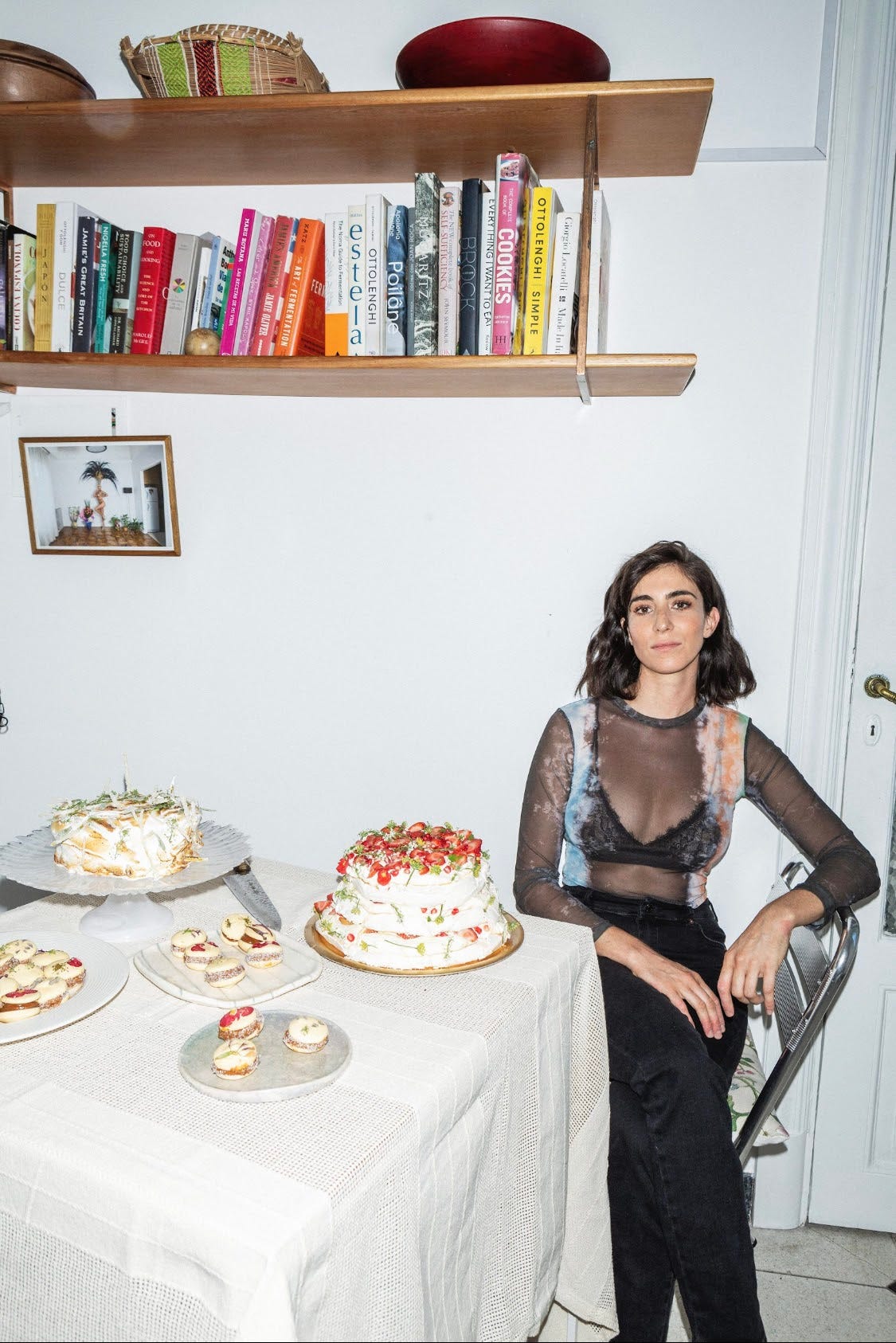
Rae Robey: Two things really stand out about your baking: the design and the look of what you bake, as well as the ingredients you’re choosing—I know you do a lot of vegan baking. But I want to start with that first piece, so: How would you describe your style, and how did it develop?
Chula Galvez: When I started selling cakes like ten years ago, I was living with my mother and would bake in her kitchen. It was super expensive because I wasn’t buying wholesale ingredients. So I bought super cheap plates to put the cakes on, and they were kind of ugly. I stole big leaves from the garden of a neighbor and I started putting them on the plate and on top of the cakes. And I used to go to Chinatown here in Buenos Aires, and sometimes I found edible flowers. I used to paint a lot when I was younger, and now it’s kind of intuitive. I just start playing around. I take a lot of time when I decorate a cake.
RR: I feel like cakes are having a renaissance on Instagram. In 2013, all of the cakes had really clean lines. Drip cakes were huge, and there was not a crumb out of place. What I really appreciate about your cakes is that they’re a little bit imperfect, the lines are not so rigid. There’s a really beautiful video you posted of taking a slice out of a cake, and the frosting tumbles to the side. Your cakes have this fairy tale, dream-like quality to them that I really love. They just feel way more personal.
CG: I love how drip cakes are perfect and everything, but I never liked buttercream. I think it’s too buttery for me. I use frosting that’s more creamy, so my cakes will never have those clean straight lines.
RR: What kind of frosting are you using?
CG: I often use a frosting that I make with cream cheese. And I make a crème anglaise with white chocolate, so it’s kind of chocolate-y but it’s not super sweet. I also use a lot of Swiss meringue—I like to dye it with powders, and it’s super shiny and glossy. Also, a lot of ganache. It depends on the cake. I’m super happy with this vegan cream that I’m making with cocoa butter, coconut oil, and some soy milk. It’s kind of like a ganache with a whipped cream texture. In vegan baking, I use a lot of cocoa butter for texture.
RR: You’ve talked about being inspired by the work of Emily Dickinson, who obviously was very moved by nature.
CG: Yeah, I love Emily Dickinson. When she was alive, she was better known as a baker than as a poet. There are a lot of poems she used to write in the envelopes of chocolate and butter, because paper was super expensive at that time. If you Google “Emily Dickinson recipes” there are some really great recipes she wrote.
RR: Have you tried any of them?
CG: Yeah, for last Christmas we did a box inspired by Emily Dickinson, with all her baking.
RR: Well, it makes sense that flowers are a huge part of your decoration style—do you grow any of them yourself or is it mostly a farmers market purchase?
CG: Now that I have a huge patio I’m growing a lot of them, but normally I have different providers. I use a lot of flowers, so if I wanted to grow them all myself I’d need a lot more space.
RR: What are you growing currently?
CG: Well now it's the season for alison, which are very tiny white flowers. I have pansies, I have clavellinas (dianthus).
RR: I’ve started doing a little bit more too—I have a very small patio, and this is my first year gardening. And my first year doing any sort of cake business type thing, too. I’m making like no money on it, for a lot of the reasons that you mentioned. But I have really enjoyed the process of tending from seed to flower, getting to know the medicinal properties of calendula and lemon balm and tulsi. I’ve never used basil flowers before, but all of mine are flowering now, and I’m exploring the different parts of the plant that you don’t necessarily get to see. Because no one’s selling basil flowers in grocery stores.
CG: Oh the most beautiful are the ones of arugula. You should get them. And now that autumn and winter is coming, it’s more of the season for greens.
RR: Great, I’ll definitely be doing that! I’ve been thinking about what I want to plant next. Recently, I’ve spent a lot of time candying and sugaring fruit, flowers, and leaves. It’s not something I ever thought I would get that much joy from — this very specific part of the decorating process.
CG: Totally, it’s worth it. It looks beautiful. And you can preserve it for a long time.
RR: I’ve learned so much from your Instagram, specifically. You shared how you press your flowers, and now I do that with my own. You also shared a recipe for a coconut milk dulce de leche that I’ve used a lot. It’s always grainy though, every time. It drives me nuts. It’s still delicious, but I can’t get that perfectly smooth dulce de leche.
CG: It kind of crystallizes the sugar, right? If you put a little bit of glucose it always helps to prevent crystallizing, like 10% of the weight of sugar.
RR: Will do. Good tip! You clearly inspire my work, and I think a lot of people would say the same. Are there people that inspire your work?
CG: Laila Gohar, I love her work. I think it’s super inspiring. Also, I love Zoë François. Erin McDowell’s baking tips are amazing. Aran Goyoaga of Cannelle et Vanille, I just got her first book. I have eczema and Hashimoto's thyroiditis and my doctor told me it’s better not to eat gluten or dairy. I’m really into Cannelle et Vanille now, because she posts a lot of gluten-free recipes. Also Loria Stern, she’s a great flower decorating pastry chef. Those are where my eyes are all the time now.
RR: I see a lot of similarities between—at least Instagram feed wise—you and Laila. There’s such a beautiful but simple art direction to the way you guys both approach your food. I actually also just got Aran’s first book! I’m exploring gluten-free stuff which is hard, especially as a baker. We’ll see.
CG: It’s not that difficult. You just need to find the cakes you like, and then you play around with those recipes. She has an olive oil and chocolate moist cake in that book, and it’s really good. You should try that one.
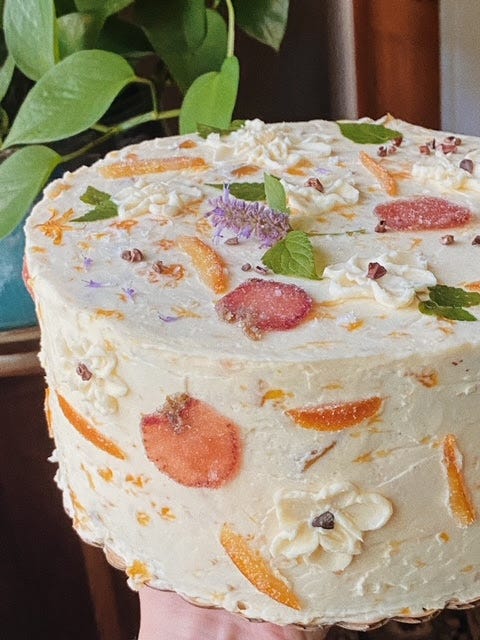
RR: I have a lot of gluten-free people in my life, so I really should figure it out. I know that vegan baking, or moving in that direction, has also been something you’ve spoken about in the past. Is everything you make vegan? Or are you still using some dairy and animal product stuff?
CG: So I’m not eating dairy, but I do use a lot of egg. There aren’t many good vegan recipes around. We base our baking more on the French techniques, and there’s not many written vegan recipes. The other day I bought a vegan baking book and I was so disappointed, everything was like, “You should use vegan butter.” We don’t have that in Buenos Aires supermarkets yet. You have to make it from scratch. I’ve been vegetarian since I was 15 years-old, and I empathize with vegans because when they go out to dinner they might only be able to eat french fries and a salad, and they never can eat dessert. So I feel it’s my duty to give them really good options. It doesn’t have to be depressing because it’s vegan, or because it’s gluten-free, or dairy-free. I think that’s my mission in a way.
RR: I suppose people see anything that’s vegan as inherently lacking, because it lacks dairy and eggs and we see those ingredients as standards. In the 2010s, I was deeply entrenched in clean eating Instagram, and so the only vegan desserts that I ever saw were medjool date and raw cashew power nut ball things. Vegan desserts were always healthified, because veganism is mistakenly wrapped up in diet culture. And then meat eating—especially in the US—is part of how we express our nationalism. “Eating meat is American.” And so there’s this instinctive revulsion when people suggest vegan food. Is that the same in Argentina?
CG: Yeah, well, Argentina is a country of meat. Everyone eats meat at every meal. When I came back to Buenos Aires during the pandemic, I was surprised how many people had changed their diets. I couldn’t believe that there were vegans in Argentina. Now, in every restaurant, they have an option for vegans and for vegetarians. One of our top chefs is even opening a vegetarian restaurant.
RR: I’ve been trying to psych myself up to really dive into vegan baking, but as you said there’s really not that many great sources to look at. And I’m self taught, so the idea of ditching all that I’ve learned and trying to start over with vegan stuff is really daunting.
CG: Yeah, it’s very frustrating sometimes because when you’re experimenting it’s like, “Oh no, this just fell apart,” or it became super liquid. It happens a lot. But there are some good recipes around. The other day I got together with an editor, and we’re going to do a vegan baking book.
RR: Wow!
CG: Yeah, I’m super happy. So hopefully you can follow my recipes soon.
RR: I would be stoked about that. I feel like that is exactly what people are really waiting for. At least, I’m waiting for it. I don’t want to have to use corporate replacements, like the Just Egg, or vegan butter. Those ingredients are really expensive, among other things. They’re much more expensive than non-vegan counterparts. Figuring out how to do so in an affordable way is something that I’m super interested in. So, fingers crossed! Have you announced that book yet?
CG: No, it was just our second meeting. But it should be for next year, like next spring (in Argentina).
RR: Wow. That’s really cool. I’m very excited for you. Count me in for your first preorder. When did you start moving towards vegan baking?
CG: Doing the dessert menu for Dimes allowed me to experiment with vegan baking. I had this mission of making a really good vegan dessert that wasn’t uglier than the other ones just because it was vegan. To your point, vegan baking is expensive. Anything that’s not butter, sugar, and flour is normally expensive. We need more diversity. Right now, wheat flour is always going to be cheaper than others. But if a lot of people start using rice flour or things like that, producers are going to start making more, which will make the cost less.
RR: I don’t know much about agricultural policy, but I do know that the US really heavily subsidizes dairy and meat, and so it makes sense. Like, of course those are the standards. Because that’s what’s easily available, and that’s what the government is pushing on us.
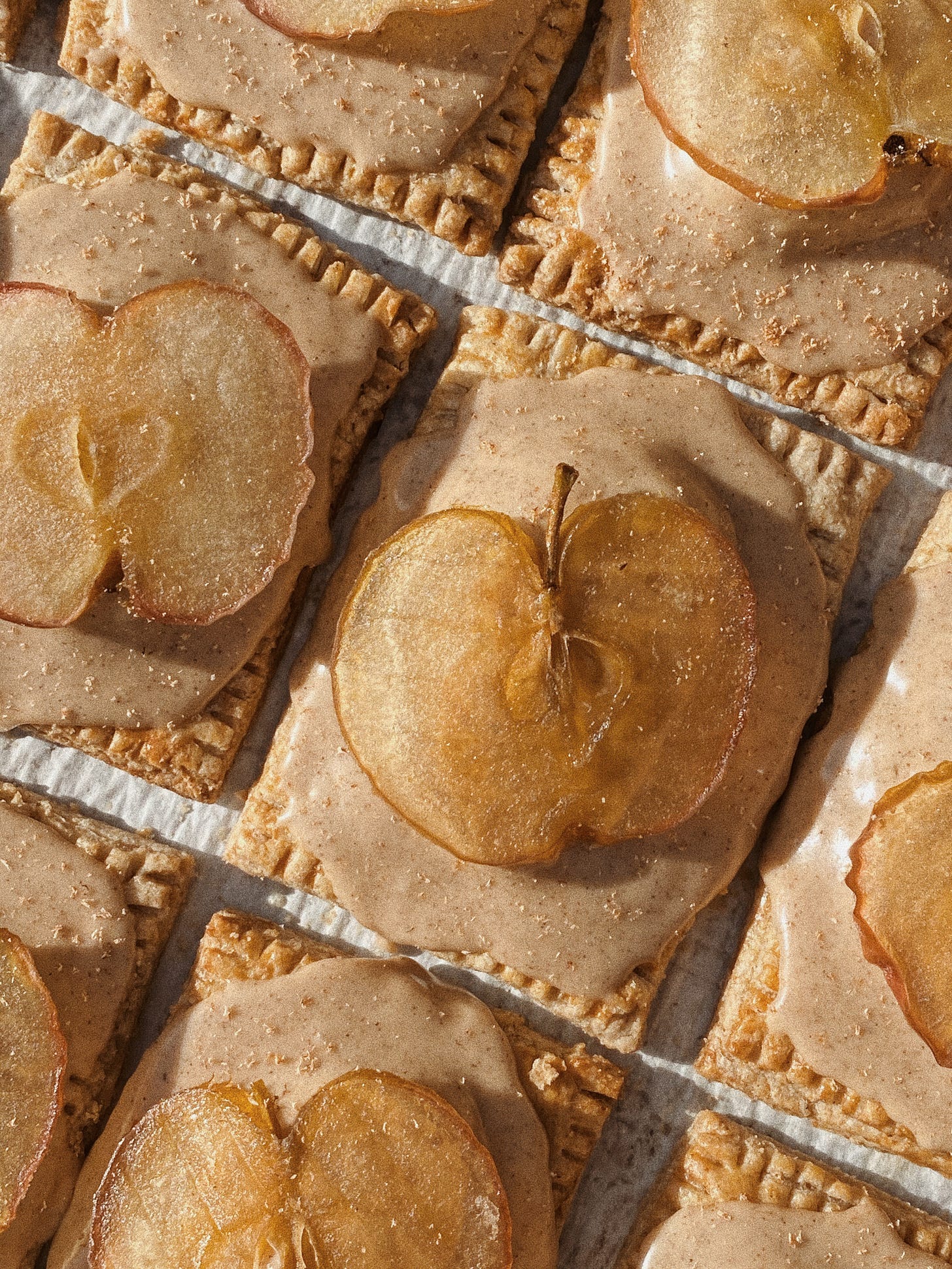
CG: We’re developing a restaurant here in Buenos Aires that we will open in March, and the other day, the guys developing the menu were discussing whether vegan or vegetable dishes should support meat dishes. Because normally in a restaurant, meat is more expensive than an aubergine dish. But the dishes end up costing the same price, and then people will always have meat instead of a very good vegetable plate. As a vegetarian, you’re paying for meat in a way. But they were like, “We can’t put the real price of meat. No one’s going to order that.” But well, it’s a more profound discussion.
The restaurant is going to be called Las Flores, which means the flowers. So it will have a lot of flowers. We’re working with friends in botany. It’s going to have a very big garden with a lot of native plants and flowers. It’s going to be very beautiful. My boyfriend, who I work super well with, will be the head chef. We’re going to have a lab where we’ll do a lot of research, and that really excites me.
RR: It seems very much up your alley. I assume you’re going to be doing the desserts and such?
CG: It’s going to be a pastry shop and a restaurant, so it’s going to be open from the morning until night.
RR: Nice! As it should be. What will be the focus of the lab research you mentioned?
CG: A lot of vegan baking for my team. We’re researching a lot about aquafaba, agar agar. The restaurant is also going to be gluten-free. And we’re not going to use any wheat flour. Not because we’re against it, just because it’s an important way to educate people. You can have things that are delicious without flour. We’re not going to even say it. Some curious people will realize, and some won’t. So that will require a lot of research. It’s super fun to work with people that think about food in another way than I do.
What’s Cooking?
Fany Gerson’s Tamal de Limón
As the country’s most authoritative voice on Mexican sweets, Fany Gerson has been featured in the New York Times, Food & Wine, Fine Cooking, Saveur Magazine, Fine Cooking, Fast Company and New York Magazine, among others. She launched the acclaimed La Newyorkina, an artisanal Mexican frozen treats and sweets business in 2010. She’s currently the chef, founder and co-owner of Fan-Fan Doughnuts, an artisan gourmet doughnut shop in Bed-Stuy. A graduate of the Culinary Institute of America, Fany has worked in a range of fine-dining kitchens around the world including 3 Michelin starred Akelarre in Spain and Eleven Madison Park in New York. She has written three books, My Sweet Mexico, which was nominated for a James beard award 2010 for Best baking and pastry cookbook Paletas and Mexican Ice Cream.
“For a few years now, my dad and his partner Manuel have made an incredible Día de los Muertos celebration in a country house located near Cuernavaca. They invite friends and neighbors, attempting to preserve the culture that many children in big cities confuse or associate nowadays with Halloween. Hundreds of assorted tamales and hot chocolate are always made to welcome the guests as they come to visit the awesome ofrenda. One year, Mrs. Catalina, the charming woman responsible for the tamale feast, kindly showed me how to make them (although she didn’t let me touch the batter because she said it would separate). The lime zest ones were my absolute favorite and remind me of a very light and airy sponge cake. The bit of shortening helps give it a wonderful texture, but you may substitute more butter if you prefer.”
Tamal de Limón
Ingredients
30 dried cornhusks
1 cup unsalted butter at room temperature
½ cup vegetable shortening
1½ cups sugar
2 cups masa harina
Green food coloring (optional)
2 cups whole milk
2 tablespoons grated lime zest
Pinch of salt
Directions
Rinse the cornhusks under cold water, place them in a bowl, and cover with boiling water (put a plate on top and weight it with a large can to keep them submerged). let sit for at least 30 minutes, or until soft.
In a bowl, combine the butter, shortening, and sugar with your hands or in a mixer with the paddle attachment until very creamy. Add the masa and mix well (it’ll look a bit like coarse meal). Combine a few drops of food coloring with 1 tablespoons of milk, then add that and the rest of the milk gradually while mixing until incorporated. Stir in the lime zest and salt.
Drain the cornhusks and scoop about ¼ cup of the batter into a husk, spreading it with the back of a spoon and leaving at least 1 inch all around (a little more on the long sides). If the husks are too small or broken, put two together and overlap them. Fold one of the long sides toward the center, and then fold the other long side on top. Tuck the exposed sides underneath; if they are still too small, wrap the tamale in another husk and tie it with a thin strip of husk (this isn’t necessary but is just an extra precaution). Repeat to use up all the batter.
Fill a pot with enough hot water to reach just underneath, but not touching, a steamer (you can use the collapsible kind if you don’t have a special pot). cover the bottom of the steamer with leftover cornhusks and arrange the tamales vertically, standing them up so they rest against one another. cover with any remaining leaves or scraps, cover with a lid, and cook over medium heat until the tamales slide out of the wrap- pers, 1 to 1½ hours. Add more boiling water to the bottom pot as needed to make sure water reaches the bottom of the steamer. Serve warm. The tamales can be stored in the freezer, wrapped tightly, for up to 3 months.
Reprinted with permission from My Sweet Mexico: Recipes for Authentic Pastries, Breads, Candies, Beverages, and Frozen Treats by Fany Gerson, copyright © 2010. Published by Ten Speed Press, a division of Random House, Inc.”
Lunch Break
A dedicated section to boost suggestions from friends & collaborators.
Nina Friend (she/her, Associate Features Editor at Food & Wine): The chill in the air is making me excited to bake again after a bit of a summertime baking break, and I can’t wait to dig into some new cookbooks—starting with Vallery Lomas’ Life Is What You Bake It (the Beignet Fingers speak to me!). Dorie Greenspan’s Baking with Dorie is filled with fun modern takes on classics, and I’m super excited to get my hands on a copy of Cheryl Day's Treasury of Southern Baking. Outside of my own kitchen, I’m itching to taste all of the desserts from storied pastry chef Claudia Fleming at the newly-opened Ci Siamo in New York City. And, fall is always my favorite time of year at Big.Fat.Cookie, my mom’s cookie company—I’ve been waiting for the candy-stuffed Halloweentown cookie and the pecan pie cookie since, well, last year.
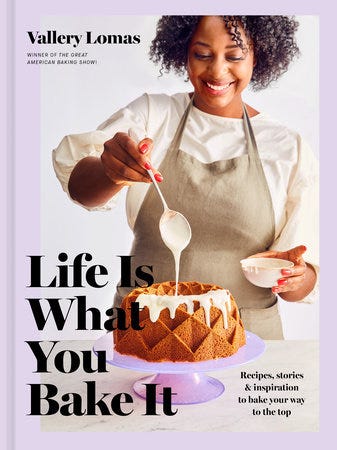
Edouard Massih (he/him, Founder & Chef at Edy's Grocer, and always catering events, shoots, and everything in between): I finally went back to a Broadway show this week — a true New York moment that I missed so much during the pandemic! I couldn’t help but think how crazy it is that so many people work endless hours to put together this 2-hour show — It truly amazes me, because I realized that I can relate. It’s exactly how I feel about my business, food, and @edysgrocer. The endless amount of hours farming, cultivating, producing, butchering, packaging, marketing, purchasing, slicing, dicing, cooking, and bringing it to a storefront — but then all being sold and eaten in a matter of minutes! There are so many moving parts when you create, and I think that’s what makes art what it is. It’s called art because a lot of work has gone into making one beautiful piece, and it doesn’t happen right away. I love seeing food as a form of art. The art of it can even go beyond just cooking the food itself, it can span to how it’s presented with the flatware, glassware, florals, candles, table, and ambiance supporting it that brings it all to life. Whether you are cooking for yourself or eating out of a pot, or catering a dinner for 22 celebrities, food will always be art, and I am so appreciative of every little step that it takes to make it happen. It’s always worth it, and it’s always the kind of art I want to make. Before the show, I had dinner at Atoboy, one of my favorite prix fixe menu restaurants in New York, also my favorites lately have been Bernie's and Chez ma Tante both in Greenpoint. As always I'm sipping on cold brew so join me weekly on my Cold Brew with Edy on @edysgrocer for a chat about food, spices, restaurants, and what the housewives are eating. Cheers
Courtney Kassel (she/her) and Gaby Scelzo (she/her, the writers behind Sifted, a weekly recipe recommendation newsletter that aims to take the guesswork out of what to cook for breakfast, lunch, dinner and beyond): I (Court) am finally reading the food writing bible (in meaning and in length) that is M.F.K. Fisher’s The Art of Eating, but for a quick bite I highly recommend this 1968 essay she published in The New Yorker. And on the note of cravings, I recently tasted the best vanilla ice cream I’ve ever had: the “John Stockton” from Philly-based, Instagram-baity 1-900 Ice Cream, which my co-writer, Gaby introduced me to. They use an online “drop” ordering system, and if that sounds like the worst, bear with me, because the ice cream is the best. The quality of dairy holds on its own, but flavors like extra dark pretzel and mix-ins like salted caramel brûlée swirl certainly don’t hurt. And me (Gab)? Since having a slice in the park last weekend, the only dessert I have eyes for is Four and Twenty Blackbirds’ salty honey pie. Custardy, caramelized, intensely sweet and intensely salty — it’s an absolutely perfect dessert. On its own, with fresh whipped cream or with a scoop of my favorite vanilla ice cream. With pie on the mind and Thanksgiving fast approaching, I’ve pulled out my favorite recipe-printed pie dishes to start baking in. My grandma gifted me her apple pie dish, and I eerily found a matching pecan pie version at my neighborhood antique store, Yesterday's News, which has a surprising amount of baking and serving tools (think: colorful bundt pans and fluted glass sundae dishes). There’s a fun cherry pie one floating around on Etsy, but act fast if you want it because I’m considering completing my collection.
Caroline Schiff (Executive Pastry Chef at Gage & Tollner, Executive Chef at Slow Up, Author of the forthcoming The Sweet Side of Sourdough): I've been more obsessed than usual with butter as of late, which is saying a lot. I currently have eight unique kinds in my fridge, and writing that down honestly feels like some kind of admission- putting it out there is a weight off my chest, like when the killer in Law & Order finally just fesses up to Stabler (ILYSM, Stabler). I don't have to keep this secret anymore! And even more of a relief is admitting that I've been tasting them by themselves, like morsels of cheese, just because. I've been trying to figure out which butter is best for each specific use, because, why not?? I have the usual suspects: Kerry Gold, Beurre D'Isigny, Plugra, Presidente... and I'm not mad at any of them. However, my most recent obsession is Meyenberg goat milk butter. It's bright white unlike its golden cow's milk counterparts, and simultaneously creamy and light; tangy and grassy. It's butter, but it's not. It's just something else, with a distinct goat dairy je ne sais quoi. I've found myself shoving my leftover sourdough from dinner service at G&T into my bag at the end of the night. I call it purse bread. It's a thing. When I get home, I slather it in the goat butter, like it's a soft, creamy cheese. I chase it with some seltzer or some wine depending on what my morning looks like. I'm obsessed with it. With butter. With goat dairy. That's all.
Thanks for dropping by our table of treats. We hope you’ve savored, learned, or even felt inspired by something you’ve seen today. Feel free to pop by with thoughts on your preferred pastry, or say hi at hello@lunch-group. Don’t forget to peruse our Instagram for more sweets. Until then, happy baking! 🍰


